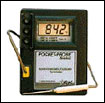05-12-02 00:33
No 307537
This "Hotbox" brand melting point tester comes in handy for testing melting points. The sample is put between two glass cover plates on the block on the left with the thermometer in it. The device is turned on and set at 10º or 20º per minute (only two settings) and you wait and watch the mercury go up the thermometer until the sample melts.


http://www.geocities.com/dritte123/PSPF.
The hardest thing to explain is the obvious
(Daddy)
05-12-02 03:38
No 307582
This should be easily reproduceble for the well equiped home hobbyist.
Remember, the glassplates are placed on top of the 2 blocks, so you can see when the sample melts.
It's not inside the blocks.
Sam, do you know what material the 2 blocks are made of? Carbon or copper or aluminum or something else?
And this thingy is meant to test melting points of SOLIDS, not fluids, to prevent any questions about that. LT/
WISDOMwillWIN
(Master Searcher)
05-12-02 04:05
No 307584
I'm refering to that thing sticking up as a block. Its more of a heating element or little hot plate with a hole in the side for a thermometer. It seems to be made of metal, its not attracted to a magnet and there seems to be a heating element in it. The paint is coming off in some places and it looks like aluminum underneath. I've seen professional versions which are similar. If you don't have any little cover plates (like the ones for microscope slides) you could probably use aluminum foil in place of them. Here's something that's similar. http://www.chem.yorku.ca/profs/hempsted/
http://www.geocities.com/dritte123/PSPF.
The hardest thing to explain is the obvious
(Master Searcher)
05-12-02 04:39
No 307590
I wonder if there are some plans somewhere or a patent to look at.
http://www.acp.edu/facultystaff/genchem/
http://www.geocities.com/dritte123/PSPF.
The hardest thing to explain is the obvious
(Hive Addict)
05-12-02 04:44
No 307592
I bet any semiconductor/resistor type of material would work...
Thanks, Sam!
Fight Terror! - support your local Alchemists, Brewers, and Cultivators Guild!
(Moderator)
05-12-02 14:07
No 307665
As previously posted, Vogel's has a similar device using a household iron as the metal block. A rheostat is used to raise the temperature, one could automate that easily. A pyrometer can be substituted for the thermometer, you can either use a glass slide for corrosive compounds, or just use the surface of the iron for any that's been washed of acid residues.
(Hive Bee)
05-12-02 16:23
No 307667
how to build a pyrometer can be found here:
http://www.metalwebnews.com/howto/optpyr
ORGY
(Moderator)
05-13-02 00:48
No 307745
SWIL's experience is with a service pyrometer with a probe such as:

but an optical pyrometer should work very well also
(Master Searcher)
05-14-02 00:48
No 308142
The pictures stopped showing up. Let's try this.
http://community.webshots.com/photo/2809
http://community.webshots.com/photo/2809
http://www.geocities.com/dritte123/PSPF.
The hardest thing to explain is the obvious